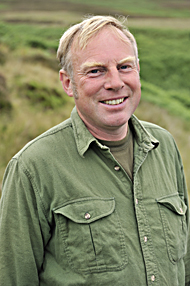
| HOME |
| PROJECT DETAILS |
| PROJECT ADMINSTRATION |
| JOINT RAPTOR STUDY |
| THE MOOR |
| THE GROUSE |
| THE RAPTORS |
| OTHER WILDLIFE |
| DIVERSIONARY FEEDING |
| GAMEKEEPING |
| WILDLIFE SURVEYS |
| NEWS |
| CONTACT |
| PHOTO GALLERY |
Previous Diaries
| Simon Lester's gamekeeping diary |
September 2011 DESPITE the process of obtaining Scotland’s first ever out-of-season burning license being more complicated that we assumed, we received the bit of paper and got the go ahead halfway through September. Ironically, this delay didn’t cost us any loss of burning days, as up here the weather has been miserable. As we were the first estate to go through this application process, I am sure that the gremlins will be sorted and that the licensing system will run smoothly in the future. We managed to burn for two days, really two afternoons, as the dew is so heavy at this time of year. There is a real autumnal feel crept up on us. The moor is changing, and what were green swathes of Molinia and other grasses, are turning quickly. The patches that we have sprayed off are no longer easy to define. It’s so late that the theory of green firebreaks has not worked in practice. Because of this, we have to take great care when burning, which requires more time and effort. However, it is good to have made a start. With the fading foliage, the meadow pipits are moving off to their winter quarters. The last of the late hatch wheatears and stonechats are also on the move. What is great news is that there are black grouse in the valley where we live for the first time since we’ve been here—what I assume to be a hen and six well-grown young. Another good brood has been seen near Newcastleton. The black cock are also back on their lek, strutting their stuff. Not everything is moving on with autumn. A creature that has been abundant all year is the vole and there are still lots around. Most days, it’s possible to see something darting through the grass out of the corner of your eye. If you examine the area there is a network of runs and holes all over the place and little piles of giveaway droppings. It will be interesting to see the results of the mustelid monitoring boards that are put out in September, as weasels love voles and their abundance may have boosted weasel numbers. This year’s young foxes that we are catching are all well-grown, fine specimens. Some say the vole is the currency of the uplands, as so many creatures depend on them as a primary food source. The shortening days are affecting the grouse which have gone into territorial mode, with the cocks becoming more vocal and making their presence felt with their crowing vertical take-offs and parachuting descents. Sadly, we are still finding too many grouse that have been killed by raptors. We all spent several nights during the month catching and radio tagging more grouse to get a good sample for this winter. All the grouse that we caught were also boxed up so that we could take caecal droppings to test for Strongyle worm. At the same time they were aged, young or old, and their breast muscle scored from one to five. All the birds had good muscle scores and their caecal pat samples showed very low egg counts, promising news for survival. Our winter research student Merlin Becker will monitor these birds more closely this winter. He will also be carrying out raptor watches from pre-determined vantage points, scanning with binoculars for a given time. We must find out what is happening to the grouse and agree what their fate has been, so that we can move forward. We are learning more and more about the hen harriers from the satellite tagging—it is interesting that harriers seem to have a magnetic attraction to grouse moors. Google earth provides a bird’s eye of land use and out of the land of similar make-up; they seem to head for areas of obvious muirburn. Out of the three birds we tagged this year, one has stayed relatively close to home, one has been around the Moorfoot Hills and one has gone off the radar somewhere south east of Carlisle, its fate not known. Damian Bubb and Tom Reid drove to the area with the receiver and, with the help of a local gamekeeper, searched the last known fix from the satellite tag, but failed to pick up a signal. McPedro has moved from the Leadhills area, a little further south, and we are all waiting to see if he will repeat his journey back to Spain—if I was him I’d have gone weeks ago. Despite the gloomy weather, I still see sights that cheer me up. Much to my delight, I saw a dipper at the ford on Tarras water. They have been absent since the winter and I missed them this summer, so it’s good to seem them bobbing about again. The blue dots of the late flowering scabious are brightening up the edge of the moor. |
